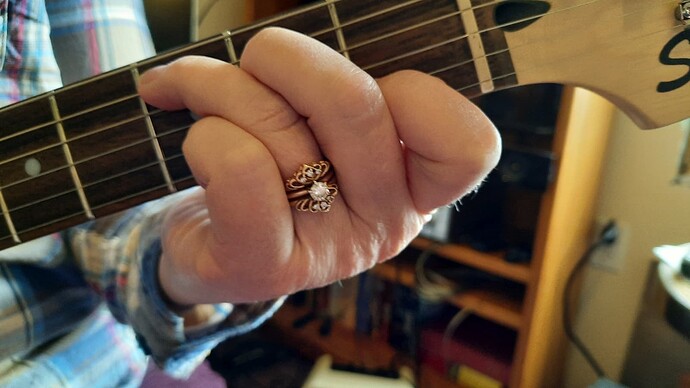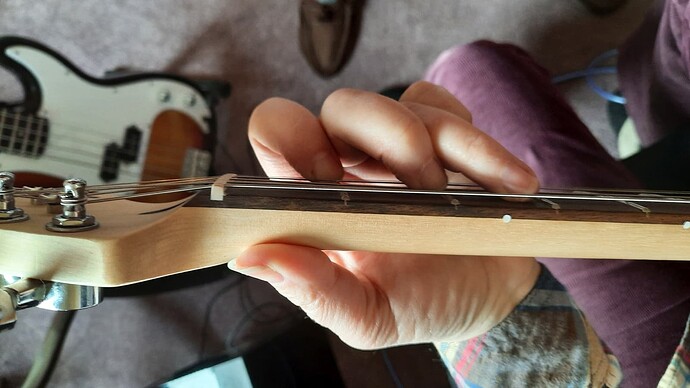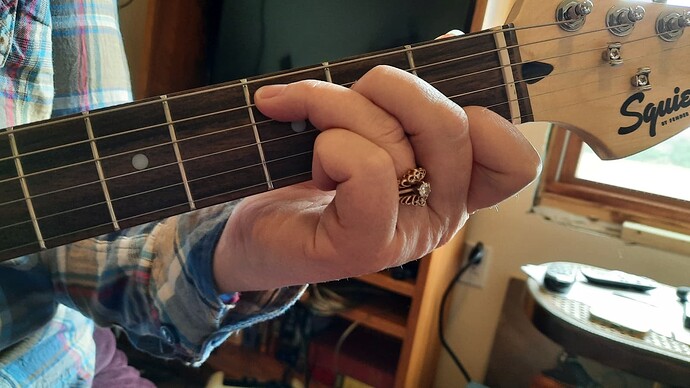It is the first really stretchy one Rebecca. Practice will continue to work out, fear not!
I didn’t watch the whole video, so I didn’t hear Justin say that, but if you watch his hand position, he certainly isn’t playing with this thumb behind the neck. He generally plays with his thumb visible above the neck. In fact, when he demonstrates the wrong way to play (at around 0:45 of the video), he drops his thumb behind the neck. Try to position your hand the way Justin has it.
I would say that if you angle your fingers correctly, it’s not that stretchy. Again, he talks about finger angle at 0:45 of the video. If you don’t angle the fingers, it is indeed stretchy (which Justin mentions).
That’s not to say that it’s easy! Getting enough curl in your fingers to not mute the other strings takes experimentation and practice.
One other tip: make sure your nails are cut short, especially on the index finger. If I have even the smallest nail protruding, I can’t get the tip of my index finger straight enough to prevent the high-E string getting muted.
Good luck!
If you’re beginner, you definitely should keep your thumb around the midline of the neck to build muscle strength for barre chords.
In a lot of his videos, he mentions his thumb being visible but doesn’t recommend that for beginners. I guess he uses it to mute this 6th string on occasion. I’ll check the video where you mentioned it, thanks.
Yeah, I understand Justin teaches this, but I never understood the logic of it. Some chords are just a lot easier if you let the thumb rest higher on the back of the neck: C and mini-barre F come to mind. It seems odd to learn a chord in a non-optimal way to achieve a completely different and unconnected goal: building hand strength.
I suppose there are other reasons for having beginners play with a low thumb. Maybe some teacher in the community (even Justin?) could weigh in.
Well, what is optimal is subjective. Like, I don’t understand how the mini barre F would be easier with the thumb higher up. Personally, I learned thumb placement in the way it was recommended in the lessons and I don’t think it made progress any more difficult.
Also, why would hand strength be unconnected to playing chords?
I’ve gotten into the habit using my little finger on the A string instead of my third finger…much easier stretch for me and really smooths out my chord changes
This is not a good idea (using pinky instead of ring finger on C chord). You will eventually want to use the pinky to fret other notes. E.g. C7 (pinky on 3rd fret, G string) Cadd9 (3rd fret, B string) and the variation of C where you add the high G note (3rd fret high-E).
The C chord can be tough, but you should keep at it with the standard grip. Good luck!
My (somewhat unpopular) opinion is that if using a non-standard technique or chord grip lets you play a song you like now, instead of some time in the indefinite future, you should do it and enjoy playing the song.
However, you should realize that there’s usually a reason for the standard way of doing things, and you will probably find your way limiting at some point, and you’ll have to learn the standard way. (Muting the thick E string in a C chord is probably easier with the ring finger, for example).
But learning new grips for the same chord is part of the learning process (for G and A, especially) so it’s not a big deal if you have to relearn C as well.
My advice would be to spend some time doing Justin’s finger stretching exercises, and come back to the standard grip for the C chord later.
In the meantime, enjoy playing your songs!
I would strongly encourage you to break that habit and use fingers 1, 2, 3.
There are many variations of C chord that need you to have the 1, 2, 3 fingering.
C7
Csus4
Cadd9
C with a high G note on fret 3 of the 1st string
C/G
C/B (especially as a link between C and Am)
Plus other chords fall in a similar overall finger pattern:
G7
G/B (especially as a link chord between, for example, Am and C)
Fmaj7
Fmaj7/G
You will need the fingering for embellishments, walking bass notes and much more as you develop.
It really is not / should not be such a struggle that you are searching for a short-term fix that will have profound long-term drawbacks.
Thanks for the honest responses…they all make perfect sense and I’ll fix this
Could some of the difficulty you are experiencing be due to hand position / angle? Justin’s video on how to play the C chord might be helpful.
Well, it’s 28 days after I first complained about the C chord and I can do it! I had to rotate my arm at the elbow to get my wrist in a better position which also helped with a few other chords and made things much more comfortable. I still don’t seem to be able to mute the 6th string but I’m not going to worry about that for now. I’m more worried OMC from C to D which is in a few of the songs I’m practicing. I’d have to get my guitar to be certain, but I think my thumb is behind the neck as well. ![]()
Edit: Well, during practice I checked out where my thumb was, for the C chord it’s definitely behind the neck pointing toward the headstock. For most of my other chords the tip of my thumb seems to be at the top of the neck, but still behind the fret board. No chance of muting any strings with it.
Hi @LunaRocket , glad that you got the C chord! I started Module 5 only two days ago and I’m far away from getting a perfect chord. My third finger just not reach the 5th string close to the fret, no way! Because of that I’m muting the 4th string. I’ve been trying different angles and stretching the best I can, but nothing is helping, quite frustrating. By far the most difficult chord since I started grade 1.
I’m also muting 3rd string during this effort to put the fingers in the right position. It’s so hard that my first finger starts to slide towards the second fret and I mess everything. Take a big breath and start again.
Well, hearing from you that you took 28 days to get it done gives me hope that someday I will learn it.
In your opinion, what was the game changer during this period, I mean, do you think your fingers were getting used to be stretched with time and practice? Or it’s more a matter of finding the right angle for your fingers?
Thanks by sharing with us your progress, I came to this discussion today exactly looking for some insight on the C chord and just found your post. I will keep practicing, maybe within a month or so from now I will make it happen!! ![]()
Hi there @andreschiavon, glad I could help. In hopes of being a little more helpful, I asked my husband to take photos of my hand. Wish he’s gotten a better front angle with my fingertips but I think you can tell where they are from above. The last photo shows how flat my wrist is and how close my palm is to the neck without touching.
And if I can just get my ring finger a little closer to the 6th string I can mute it. But so far when I do, I don’t have enough pressure on the 5th string to have it ring out. In the meantime, I just try not to strum that 6th string.
Practice, practice, practice!
Awesome! Thank you so much for the photos, this definitely helps a lot! Unfortunately I couldn’t practice in the last two days but hopefully I will be able to return to my regular practice time this Thursday. ![]()
I’m an idiot. I do not understand how “muting” with my ring finger is possible. All I can do is (at best) fret the E string. How is it possible to completely mute the string while still fretting the A string with the same finger? What am I missing?
@Roland1911 You just touch the E string on the side with the tip of your finger it won’t make it completely silent but it won’t ring out. you just don’t want to press it down on the frets. And you are not an idiot.
This is what it looks like when I do it. I’m fretting the A string while just touching the E string with my fingertip.
But I had a lot of trouble with this at first on my guitar - I think it has a wider neck.
So I switched to thumb muting, which worked better for me. But it took many weeks of practice to make the switch.
If it’s any consolation, I’ve been playing the C chord for almost 2 years now, and I still work on it periodically.
Your thumb is up behind your index finger. If you brought it back behind your middle finger, you might find you can fret harder with the ring finger. It can work better in opposition to the thumb, if that makes any sense.
Also, I notice your fingers seem pressed together. Probably OK if they are just lightly touching. But if they are jammed together with a lot of pressure, you might benefit from doing some more Beginner Finger Stretches.






